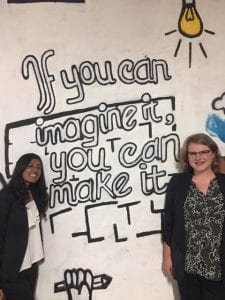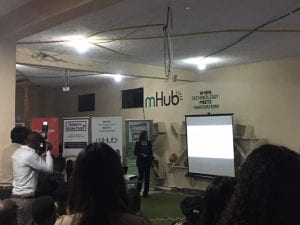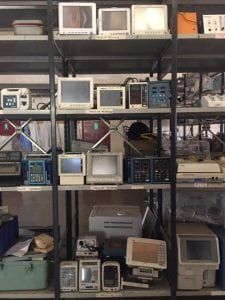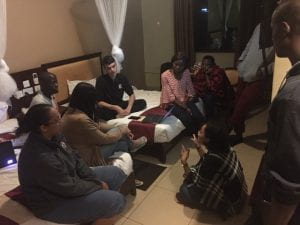We spent Wednesday, Thursday, and Friday of this week in Lilongwe. There was a pitch competition happening at this place called mHUB. Alongside the Lemelson Foundation and Rice 360, mHUB supports what they call “innovation education”. In other words, they help empower young people to execute their amazing ideas. Ten engineering design teams from different universities across Malawi made it through the audition process in order to compete in the pitch competition on Thursday night at mHUB.

I was happy to see several familiar faces: Dr. Richards-Kortum, Dr. Oden, Georgia, and Raj! We missed Dr. L and Karen though. 🙁 I imagine the 360 office in Houston feels a bit empty these days, since it seems like this is the time of year that many of them travel here to Malawi.
I really enjoyed watching the ten teams present their work. They were beyond impressive. One of my favorite teams presented an app to aid deaf people in Malawi by translating speech to sign language. Another impressive prototype was presented by our friends from MUST! Before we arrived in Malawi and began this internship, they created a prototype for a manual breast-milk pump and delivery system for premature babies who have a hard time latching onto the breast after birth. These young engineers and entrepreneurs are so smart and capable, and it made me think about my own team projects back at Rice, and how our success stories are largely attributable to the endless amount of resources and support that universities in the US offer their students (especially at Rice). I feel so spoiled: In the US, university students have access to labs stocked with any materials we could ever need. At Rice specifically, we have the OEDK, which is a huge facility and features employees and lab techs that are almost always available to give teams technical support. Engineering students at universities in the US have so many resources, and I know students here do not enjoy these same benefits. Don’t get me wrong, the design studio here at Poly is wonderful. It’s enabled so many teams to bring amazing ideas to fruition. But I can’t help but hold in my mind the idea that the OEDK is larger, more equipped, more heavily staffed, and undoubtedly much more funded. I don’t know if I have what it takes to have brought OxyMon to the success it has had if I hadn’t been given everything I needed in the OEDK at Rice.

The issue of funding is not localized to the experience of student-engineers: It is the same at the hospitals we’ve visited. In Lilongwe this week, we had the chance to meet with a medical engineer who works in Physical Assets Management (PAM) at the Kamuzu Central Hospital in Lilongwe. The medical engineer we spoke to was wonderfully helpful, and I’ve made a mental note to put him in contact with Rice 360. He’d make a great project mentor. He outlined for us a list of what he sees are the primary challenges of the PAM at KCH:
- Under-staffing
- Procuring consumables and spare parts for broken machines
- A lack of tools necessary to fix broken medical equipment
- Language barriers – donated equipment often comes with manuals in foreign languages, thus they don’t know how to install or fix these machines when they break
- Dust and moisture levels are big contributors to equipment breaking down
He told us that these challenges are, in his eyes, the biggest things preventing PAM at KCH from providing and maintaining all the medical equipment necessary for the hospital to function. A quick look at this list tells me that there is one issue that most of these challenges boil down to: financial constraints. Like the teams presenting at mHUB, the staff at PAM in KCH – and truly all the hospitals we’ve visited – are constrained by money from doing the most they can do. Now, I don’t want it to sound like I am pitying these people or saying that they’re somehow lesser than engineers in the US for their lack of funding. If anything, these people are more capable, more resourceful, and 110% more hardworking. They’re forced to find clever solutions to problems that engineers in the US might solve simply by buying more expensive equipment. They work harder: Nanah once told me that she was doing a project for a lab in Tanzania, and her team spent days tracking down one critical part for their circuit. In the US, we’d probably just go to Amazon, use our lab’s money to pay for the part, and receive it in the mail two days later. We are lucky and spoiled, and I am impressed every day with the amazing things that both young engineering interns and staff members in hospitals manage to do despite the constraints they face. I feel more and more grateful for the resources I have access to in the US, and I feel a sense of renewed devotion to make the most out of my time at Rice in order to truly take advantage of what Rice offers and prepare myself for a career being the best I can possibly be.

My favorite moment of the week happened the night before the competition. That day, all 19 interns from the US, Malawi, and Tanzania traveled five hours from Blantyre to Lilongwe. We stayed in a hotel together, and after dinner we all gathered in someone’s room to help Alex’s team practice their pitch. Presenting on their team’s behalf was Rachel from MUST. It was a challenging pitch, because all the information had to be presented in under four minutes! I thought it was really special to witness all us interns gathering together at 10pm on a Wednesday night to support Alex and Rachel’s team (also including Betty and Rodrick). It wasn’t work hours, we didn’t have to be there, but almost everyone was present, sitting, listening, and offering advice. We were all genuinely invested in the success of their team, despite having our town teams to worry about, and I found that very touching. As much as stereotypes characterize engineers as being anti-social, loners, or bad at communication, I’ve witnessed us being exactly the opposite. Especially in global health, us engineers are a community. Rather than competing with each other, we work together, and I’m so grateful to be working in this field with these people.
